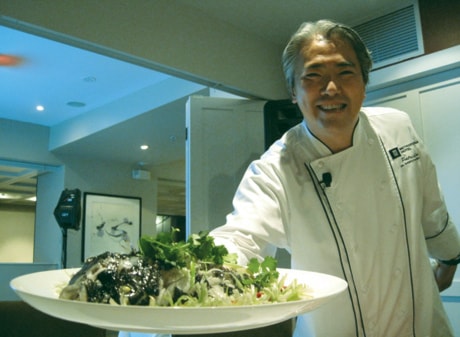TORONTO — The typical path of a Chinese formal dinner goes something like this: meat, fish, soup, fish, meat, fish.
With every dish, complementary opposites collide in the yin-yang tensions of sweet and sour, soft and crunchy or hot and cold.
Such pleasing fusions require equally complex cooking processes.
That’s why many diners feasting the Chinese way feel befuddled by the flurry of flavours and opt for a pricey Bordeaux wine.
The reasoning goes thus, wine experts say: an expensive wine won’t necessarily complement the Peking duck or shark fin soup, but it does match my Canali shoes and the Jag out back.
This status-oriented approach to wine and Chinese food is set to change, if a trio of Canadian epicures have their way.
“Far be it from us to say a bottle of grape Bordeaux isn’t great,” says Henry Wu, president of Metropolitan Hotels and Toronto and Vancouver restaurants including Lai Wah Heen and Lai Toh Heen.
“We’ve got nothing against them, but they may not be the best match. That’s the point. Wine pairing is a fun way to spice up a dinner.”
With Tony Aspler, wine educator and author, and Patrick Lin, senior chef at Metropolitan Hotels, Wu embarked on a series of eight-course dinners over four nights last year to see what wines work best with traditional Cantonese fare.
They tried two to three wines per dish, nearing 100 tastings in total.
“That was really hard,” Aspler says, laughing. “It was an intellectual, gastronomical and hedonistic exercise.”
Roger Dagorn, master sommelier and maitre d’hotel at New York City’s Chanterelle restaurant, contributed his expertise to the study later on. The team presented their findings at the 2008 conference of the James Beard Association, a culinary appreciation society.
Lin joined a roster of chefs including Toronto’s Terrence Chan, New York’s Susur Lee and others from Shanghai, Las Vegas, Hong Kong and Philadelphia to prepare the gala dinner.
He served tea-smoked duck breast, cold lobster in jelly, and vegetable marrow with assorted vegetables with The Black Chook Sparkling Shiraz NV and Feudi di San Gregorio Ros’aura Rosato 2007.
Now, nine months later, Lin shows unflagging enthusiasm for the project. At the Lai Toh Heen restaurant in Toronto, he brandishes a glistening Peking Duck on a platter as Aspler recommends 2006 Pinot Noir from the Scott Cellars in Santa Barbara.
Wu, Aspler and Lin recently hosted a traditional Cantonese banquet with wines at Lai Toh Heen to bring their message home: well-matched, wine can actually mimic and complement the yin-yang tensions in Chinese food.
In other words, less expensive wines may do a better job of highlighting the flavours in a multi-course dinner.
Like a culinary jack-in-the-box, Lin appeared and re-appeared with eight dishes ranging from roast suckling pig to wok-fried jumbo prawns and scallops, braised dried abalone and steamed whole black bass.
Six wines accompanied the parade of flavour and texture, including Riesling, Pinot Noir, Vouvray, Chablis and Pouilly Fuisse.
“We’re being spoiled tonight to have a wine with every course,” Aspler said. He added that a group ordering only two wines should choose one red and one white, such as a Pinot Noir and a Riesling, versatile enough to match most dishes.
The standard Western banquet runs in a more direct fashion than a traditional Cantonese one, Aspler says, from soup to fish to meat to dessert.
Western cooking methods are simpler, too. In essence, chefs apply heat to basic, fresh ingredients and garnish with spices or apply a sauce.
The sequence and composition of Western dishes makes wine matching straightforward: begin with white, continue with reds of increasing weight and concentration and finish with a dessert wine.
The challenge with the more circuitous Chinese approach to fine dining is to find wines that not only suit the food but also go well with each other, Aspler says.
The other challenge is to overcome the myth that Chinese food must go with expensive Bordeaux wines.
In Hong Kong and China especially, people almost automatically choose expensive reds to go with traditional pig, duck and abalone, Wu says.
Two years ago, he brought Chablis to a celebrated restaurant in Hong Kong, only to find that the waiter had never seen a bottle of white wine before.
“I thought to myself then and there, oh my gosh, we better do something about the topic of matching Chinese food with wine.”
Wu says similar studies have been done in the past, typically sponsored by wine orchards. In this case, wine merchants and government agencies did not participate in the study.
“We weren’t setting out to prove that a particular type of wine works with Chinese food, whether Ontario or red or white, but just finding out what works,” Wu says.
Their next goal is to find the best dessert wines for Chinese sweets.
Versatile Wines
Ideally, each dish in a Chinese dinner should be served separately with a different wine, with water and green tea on hand to cleanse and refresh the palate between courses.
